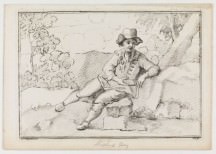245 (Title and Statement of Responsibility) Required
Single items.
The prescribed source of information for the title and statement of responsibility area for graphic materials is text (printed, manuscript, or electronic) provided by the creator or creating body on or with the material.
If parts of the title are scattered over the item, compose the title proper based on those elements distinguished by position, typography, or size of lettering. If the text could reasonably be assembled in a different order, provide additional title access if considered important. Transcribe additional title information, alternative titles, parallel titles, etc. as usual. Abridge a long title only if it can be abridged without loss of essential information. Use a mark of omission (…) and never omit any of the first five words.
Do not include a general material designation (GMD). Do not include a statement of responsibility unless transcribing it along with an associated transcribed title.
Single item from a multipart resource.
Do not use the series title as the title proper unless cataloging the series itself as a multipart resource (see below) or the part or section title is dependent on the title of the larger resource. Use the part or section title of the item being described as the title proper.
No title on item.
If no title can be found on or with the material, and the material has sufficient non‐incidental text (i.e., more than just numbering, a mailing address, etc.), use the beginning words of such text as the title proper. Incidental information determined not chosen as the title and/or statement of responsibility (e.g., numbering, mailing address, customer name) may be described or transcribed in a note.
When there is no title or title‐like information to transcribe, but a title can be supplied from another source (e.g. a reference source), transcribe it from that source and enclose it in square brackets. Cite the source in a note.
If no title can be derived from text on or with the material, devise a brief descriptive title as the title proper, and enclose in square brackets.
 |
245 10 ‡a [Head of Diana] / ‡c W. Hogarth pinxt. ; Sam. Ireland ft. |
 |
245 10 ‡a [Portrait of shepherd boy sitting on a rock] / ‡c W. Hogarth delt. ; S.I. fe[cit]. |
 |
245 10 ‡a The lottery ticket, or, The sunshine of hope. 246 1 ‡a Sunshine of hope |
 |
245 10 ‡a Building houses with cards : ‡b engraved after the original painting in Vaux Hall Garden / ‡c F. Hayman pinxt. ; L. Truchy sculpt. |
For untitled images of a documentary nature, give the objective factual content clearly and concisely, enclosed in square brackets. Details of the content, nature, scope, context, purpose, etc., of the material may be fully described in the note area. Include the follow:
- the subject type or form of material, e.g., view(s), portrait(s), sketch(es)
- an identification of the main subject(s) depicted (i.e., persons, events, activities, and objects)
- geographical location(s) depicted, if known and significant
- the date (including month and day, if considered important) or span dates of what is being depicted if different from the date of publication or execution
**Always make a note on the source of the title, e.g.,
500 __ ‡a Title from caption below image.
500 __ ‡a Title from banner in image.
500 __ ‡a Title from a published catalogue issued with collection.
500 __ ‡a Title from Catalogue of prints and drawings in the British Museum.
500 __ ‡a Title devised by cataloger.
Multipart resouces.
When preparing a description for a multipart resource that bears a clearly identifiable and consistently used comprehensive title on some or all of its items, transcribe this as the title proper. If considered important, transcribe the title proper of the individual items themselves in a contents note.
Statement of Responsibility
Transcribe the names of persons and corporate bodies responsible for the intellectual and artistic content material when these names appear on or with the material. Examples include architectural firms, artists, cartoonists, designers, draftsmen, engineers, illustrators, painters, photographers, photo studios, and printmakers. Include any phrases and abbreviations that indicate their role.
Transcribe statements of responsibility found in printed, manuscript, or electronic text on or with the material in the form in which they appear. In case of doubt as to its origin, treat manuscript text as item‐specific.
Do not supply or devise a statement of responsibility.
245 … ‡c drawn by Mrs. Ellen B. Mason, from a photograph
… ‡c C. Ansell, delt. ; F. Jukes, aqt.
… ‡c negative by T.H. O'Sullivan ; positive by A. Gardner
… ‡c respectfully submitted to the President of the U. States by B. Henry Latrobe, survr. of the Capitol, U.S., April 24th, 1817
… ‡c J.C.H. Grabill, photographer, Deadwood and Sturgis, Dakota Ter.
… ‡c the Grabill Portrait and View Co., Deadwood, S. Dak.
Do not transcribe names of publishers, manufacturers, distributors, sponsor/advertisers, or copyright holders in this element unless the information is grammatically or visually inseparable from the statement of responsibility.
When a single statement of responsibility names more than one person or corporate body performing the same function or with the same degree of responsibility, transcribe all the names mentioned. Optionally, if the responsible persons or bodies named in a single statement are considered too numerous to list exhaustively, all after the third may be omitted. Indicate the omission by the mark of omission and supply after it in square brackets a phrase in the language and script of the cataloging agency to convey the extent of the omission.
/ ‡c idee e motti di Giannino Antona-Traversi ; disegni di G. Ardy, A. Bonzagni, A. Cagnoni ... [and 7 others] ; sculture di V. Franco